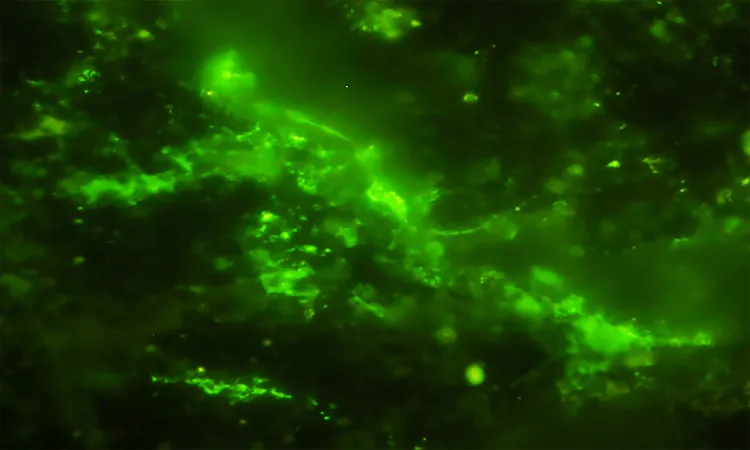
Astonishing Discovery: Microbes Thriving in 2 Billion-Year-Old Rock!
2024-10-11
Author: Mei
Introduction
In a groundbreaking revelation from beneath the Earth’s surface, scientists have discovered living microbes encapsulated within a 2-billion-year-old rock sample. This remarkable finding not only reshapes our perspective on life's endurance but also unveils new avenues for scientific exploration.
The Discovery
Lead researcher Yohey Suzuki, an associate professor from the Graduate School of Science at the University of Tokyo, expressed his enthusiasm for this unprecedented discovery. “We didn’t know if 2-billion-year-old rocks were habitable,” he stated. Previously, the oldest geological layer known to harbor living microorganisms was a mere 100 million years old, located beneath the ocean floor. This new evidence opens up exciting possibilities regarding the resilience of life through geological time.
Location and Geological Context
The ancient microbes were found in the Bushveld Igneous Complex (BIC) in northeastern South Africa, an area renowned not only for its wealth of metals—including about 70% of the world’s platinum—but also for its geological stability. The BIC's formation from slowly cooled magma has resulted in a pristine environment that has preserved these microorganisms for eons.
Sampling Process
The research team, aided by the International Continental Scientific Drilling Program, extracted a core sample measuring 30 centimeters from a depth of approximately 50 feet. This rock, ranging up to 5.5 miles thick, has remained undisturbed for millennia, providing an ideal habitat for life to persist without external influences.
Microbial Analysis
Upon careful analysis, the researchers identified dense clusters of microbial cells within microscopic cracks, which were hermetically sealed with clay. This natural barrier facilitated a stable microenvironment where the organisms could survive with minimal metabolic activity over extensive periods—almost as if living in slow motion.
Validation Techniques
To validate the authenticity of these microbial entities, the team employed advanced techniques including infrared spectroscopy, electron microscopy, and fluorescent microscopy. These methods confirmed the presence of living organisms native to the rock, eliminating the possibility of contamination.
Significance of Clay
One of the most intriguing aspects of this research is the role of clay in the preservation of the microbes. The clay acted as a protective seal, creating microenvironments that may hold clues to life’s adaptability. This revelation prompts intriguing questions about the existence of similar mechanisms elsewhere, including on Mars. Could we potentially discover preserved life forms on other planets due to analogous conditions?
Broader Implications
The implications of this discovery extend far beyond Earth. It sparks curiosity about the early evolution of life, shedding light on how early organisms adapted to extreme and isolated environments. With NASA’s Mars Perseverance rover set to return rocks comparable in age to the samples studied, Suzuki expressed his excitement over the future possibilities. “Finding microbial life in ancient Earth samples and confirming their authenticity gives us hope for what we might discover on Mars,” he said.
Conclusion
This breakthrough marks not only a milestone in the study of ancient life on Earth but also a significant step towards answering the age-old question of extraterrestrial life. As we refine our techniques for detecting ancient microbes, the potential for finding similar life forms elsewhere in our solar system grows ever more tantalizing.
Further Research
These microbes serve as living time capsules, offering invaluable insights into Earth’s history and the enduring nature of life. This research paves the way for interdisciplinary collaboration to unravel the mysteries surrounding life's origin and adaptability.
Final Thoughts
Ultimately, the revelation that life can thrive in such extreme environments challenges our assumptions about living organisms. It illustrates that life is remarkably resilient, capable of surmounting the most inhospitable conditions. The quest to understand these ancient microbes not only enriches our knowledge about life on Earth but also ignites hope for future discoveries beyond our planet.
Publication Details
This landmark study was published in the journal *Microbial Ecology*, and it continues to inspire researchers worldwide. As we delve deeper into Earth's hidden corners, the stories these ancient microbes have to tell may hold the keys to a broader understanding of life's tenacity across the universe.




 Brasil (PT)
Brasil (PT)
 Canada (EN)
Canada (EN)
 Chile (ES)
Chile (ES)
 España (ES)
España (ES)
 France (FR)
France (FR)
 Hong Kong (EN)
Hong Kong (EN)
 Italia (IT)
Italia (IT)
 日本 (JA)
日本 (JA)
 Magyarország (HU)
Magyarország (HU)
 Norge (NO)
Norge (NO)
 Polska (PL)
Polska (PL)
 Schweiz (DE)
Schweiz (DE)
 Singapore (EN)
Singapore (EN)
 Sverige (SV)
Sverige (SV)
 Suomi (FI)
Suomi (FI)
 Türkiye (TR)
Türkiye (TR)